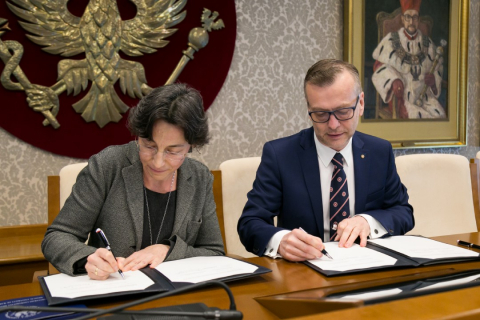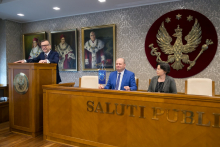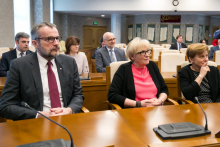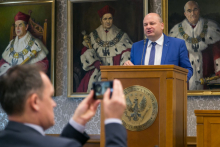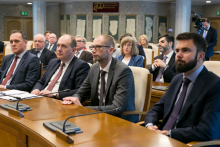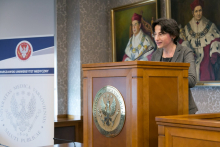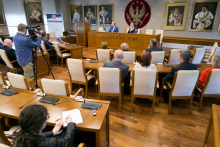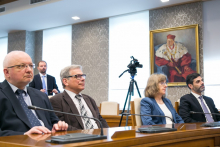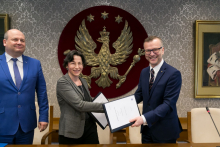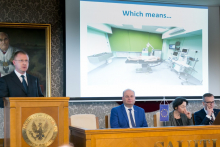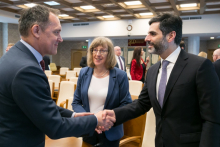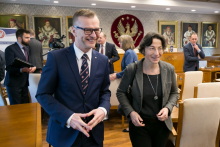The agreement was signed by His Magnificence Prof. Mirosław Wielgoś, Rector of the Medical University of Warsaw and Ms. Sandrine Croset, Director of the EIB Baltic Sea and Northern Europe Department, and in the presence of the Undersecretary of State in the Ministry of Investment and Development, Mr. Witold Słowik.
Also representing MUW were: Prof. Barbara Górnicka, Deputy Rector for Student Affairs and Education; Prof. Jadwiga Turło, Deputy Rector for Science and Technology Transfer; Prof. Wojciech Braksator, Deputy Rector for Clinical and Investment Affairs; Prof. Kazimierz Szopiński, Vice Dean of the Faculty of Medicine and Dentistry; Prof. Peter Wroczyński, Dean of the Faculty of Pharmacy; Ms. Małgorzata Rejnik, Chancellor, and Vice Chancellor, Ms. Dorota Gawrońska - Wojcik, as well as, the Head of the Second Department of Anesthesiology and Intensive Care, Dr. Gregory Niewiński; and, Dr. Marcin Kaczor, PhD., Project Manager of MUW’s new medical simulation center.
Accompanying Ms. Croset from the EIB were Vasco Amaral Cunha, Loan Officer at Poland and Baltic States Public Lending and Infrastructure of the Baltic Sea and Northern Europe Department and, Andrea Morawski, Senior Media Officer at EIB.
Opening the meeting, Prof. Mirosław Wielgoś said: “The funds received from the European Investment Bank will enable us to finance the creation of an independent innovative center offering state-of-the-art solutions for under- and postgraduate training courses. This Centre will help to enhance the quality of medical education in its practical aspects, as well as to offer opportunities for gaining experience in terms of medical treatment and patient care. Studies show that medical simulation centers increase the effectiveness of medical students’ experimental learning and the highly-realistic simulation environments help improve patient care for practicing doctors.”
The Rector added, "I am convinced that the joint contribution of the Medical University of Warsaw and the European Investment Bank will result in the creation of a world class medical simulation center, which will serve our patients who are, after all, the benefactors of our training."
Ms. Corset noted: “This is a very important project for the EIB. For the first time, we are supporting a university in Poland without the mediation of the Ministry of Finance.”
Mr. Kaczor talked about the advantages of MUW’s current medical simulation center, as well as, the need to build a modern medical simulation center that meets European and international standards.
Mr. Słowik gave a short summary of the current investments in Poland under the Juncker Plan. According to the Undersecretary of State in the Ministry of Investment and Development, "the Medical University of Warsaw is the 20th firm or institution in Poland to receive a loan under the Investment Plan for Europe, or Juncker Plan. We have six further operations in the pipeline with a positive decision by the EIB that are waiting for signature. That will bring us up to 26 transactions overall for a total value of more than 10 billion PLN which places Poland as the fifth largest recipient of loans under the Juncker Plan.”
EIB support in the amount of PLN 100 million (about EUR 24 million) will also be invested in the thermo-modernisation of the Faculty of Pharmacy building and the refurbishment of the MUW’s building on Litewska street located in downtown Warsaw.
The Medical Simulation Center of the Medical University of Warsaw
The Medical Simulation Center of the Medical University of Warsaw will be the largest facility of this type in Poland. The building will have medical simulation technology for the education and training in the fields of intensive therapy, otolaryngology, surgery, anesthesiology, gynecology and obstetrics. The building was designed by KVP Medic and will have a spiral shaped architecture with teaching, administrative and social zones.
Marta Wojtach, Klaudia Wendycz
Press Office
Translation: Delfina Święćkowska, Department of International Relations, Development and Promotion
Fot. Michał Teperek
Dział Fotomedyczny WUM
